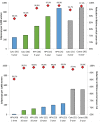Optimal Cervical Cancer Screening in Women Vaccinated Against Human Papillomavirus
- PMID: 27754955
- PMCID: PMC5068562
- DOI: 10.1093/jnci/djw216
Optimal Cervical Cancer Screening in Women Vaccinated Against Human Papillomavirus
Abstract
Background: Current US cervical cancer screening guidelines do not differentiate recommendations based on a woman's human papillomavirus (HPV) vaccination status. Changes to cervical cancer screening policies in HPV-vaccinated women should be evaluated.
Methods: We utilized an individual-based mathematical model of HPV and cervical cancer in US women to project the health benefits, costs, and harms associated with screening strategies in women vaccinated with the bivalent, quadrivalent, or nonavalent vaccine. Strategies varied by the primary screening test, including cytology, HPV, and combined cytology and HPV "cotesting"; age of screening initiation and/or switching to a new test; and interval between routine screens. Cost-effectiveness analysis was conducted from the societal perspective to identify screening strategies that would be considered good value for money according to thresholds of $50 000 to $200 000 per quality-adjusted life-year (QALY) gained.
Results: Among women fully vaccinated with the bivalent or quadrivalent vaccine, optimal screening strategies involved either cytology or HPV testing alone every five years starting at age 25 or 30 years, with cost-effectiveness ratios ranging from $34 680 to $138 560 per QALY gained. Screening earlier or more frequently was either not cost-effective or associated with exceedingly high cost-effectiveness ratios. In women vaccinated with the nonavalent vaccine, only primary HPV testing was efficient, involving decreased frequency (ie, every 10 years) starting at either age 35 years ($40 210 per QALY) or age 30 years ($127 010 per QALY); with lower nonavalent vaccine efficacy, 10-year HPV testing starting at earlier ages of 25 or 30 years was optimal. Importantly, current US guidelines for screening were inefficient in HPV-vaccinated women.
Conclusions: This model-based analysis suggests screening can be modified to start at later ages, occur at decreased frequency, and involve primary HPV testing in HPV-vaccinated women, providing more health benefit at lower harms and costs than current screening guidelines.
© The Author 2016. Published by Oxford University Press. All rights reserved. For Permissions, please email: journals.permissions@oup.com.
Figures



Comment in
-
When Less is More.J Natl Cancer Inst. 2016 Oct 18;109(2):djw240. doi: 10.1093/jnci/djw240. Print 2017 Feb. J Natl Cancer Inst. 2016. PMID: 27756809 No abstract available.
Similar articles
-
Adapting cervical cancer screening for women vaccinated against human papillomavirus infections: The value of stratifying guidelines.Eur J Cancer. 2018 Mar;91:68-75. doi: 10.1016/j.ejca.2017.12.018. Epub 2018 Jan 12. Eur J Cancer. 2018. PMID: 29335156 Free PMC article.
-
Cost-effectiveness of cervical cancer screening with primary human papillomavirus testing in Norway.Br J Cancer. 2012 Apr 24;106(9):1571-8. doi: 10.1038/bjc.2012.94. Epub 2012 Mar 22. Br J Cancer. 2012. PMID: 22441643 Free PMC article.
-
Cost-effectiveness of cervical cancer screening: cytology versus human papillomavirus DNA testing.BJOG. 2012 May;119(6):699-709. doi: 10.1111/j.1471-0528.2011.03228.x. Epub 2012 Jan 18. BJOG. 2012. PMID: 22251259 Free PMC article.
-
The cost-effectiveness of human papillomavirus screening for cervical cancer. A review of recent modelling studies.Eur J Health Econ. 2005 Mar;6(1):30-7. doi: 10.1007/s10198-004-0254-1. Eur J Health Econ. 2005. PMID: 15682286 Review.
-
[New strategies for the prevention and control of cervical cancer in Chile.].Salud Publica Mex. 2018 Nov-Dic;60(6):713-721. doi: 10.21149/8577. Salud Publica Mex. 2018. PMID: 30699276 Review. Spanish.
Cited by
-
Human papillomavirus vaccination for adults aged 30 to 45 years in the United States: A cost-effectiveness analysis.PLoS Med. 2021 Mar 11;18(3):e1003534. doi: 10.1371/journal.pmed.1003534. eCollection 2021 Mar. PLoS Med. 2021. PMID: 33705382 Free PMC article.
-
Advances in Designing and Developing Vaccines, Drugs and Therapeutic Approaches to Counter Human Papilloma Virus.Front Immunol. 2018 Nov 12;9:2478. doi: 10.3389/fimmu.2018.02478. eCollection 2018. Front Immunol. 2018. PMID: 30483247 Free PMC article. Review.
-
The Future of Cervical Cancer Prevention: From "One-Size-Fits-All" to Personalized Screening.J Pers Med. 2023 Jan 17;13(2):161. doi: 10.3390/jpm13020161. J Pers Med. 2023. PMID: 36836396 Free PMC article.
-
Nanoparticles Based on Poly (β-Amino Ester) and HPV16-Targeting CRISPR/shRNA as Potential Drugs for HPV16-Related Cervical Malignancy.Mol Ther. 2018 Oct 3;26(10):2443-2455. doi: 10.1016/j.ymthe.2018.07.019. Epub 2018 Jul 25. Mol Ther. 2018. PMID: 30241742 Free PMC article.
-
Cervical cancer screening by cotesting method for Vietnamese women 25-55 years old: a cost-effectiveness analysis.BMJ Open. 2025 Jan 22;15(1):e082145. doi: 10.1136/bmjopen-2023-082145. BMJ Open. 2025. PMID: 39843369 Free PMC article.
References
-
- Moyer VA. Screening for Cervical Cancer: US Preventive Services Task Force recommendation statement. Ann Intern Med. 2012;156:880–891. - PubMed
-
- Future II Study Group. Quadrivalent vaccine against human papillomavirus to prevent high-grade cervical lesions. N Engl J Med. 2007;356(19):1915–1927. - PubMed
-
- Paavonen J, Naud P, Salmeron J, et al. Efficacy of human papillomavirus (HPV)-16/18 AS04-adjuvanted vaccine against cervical infection and precancer caused by oncogenic HPV types (PATRICIA): Final analysis of a double-blind, randomised study in young women. Lancet. 2009;374(9686):301–314. - PubMed

